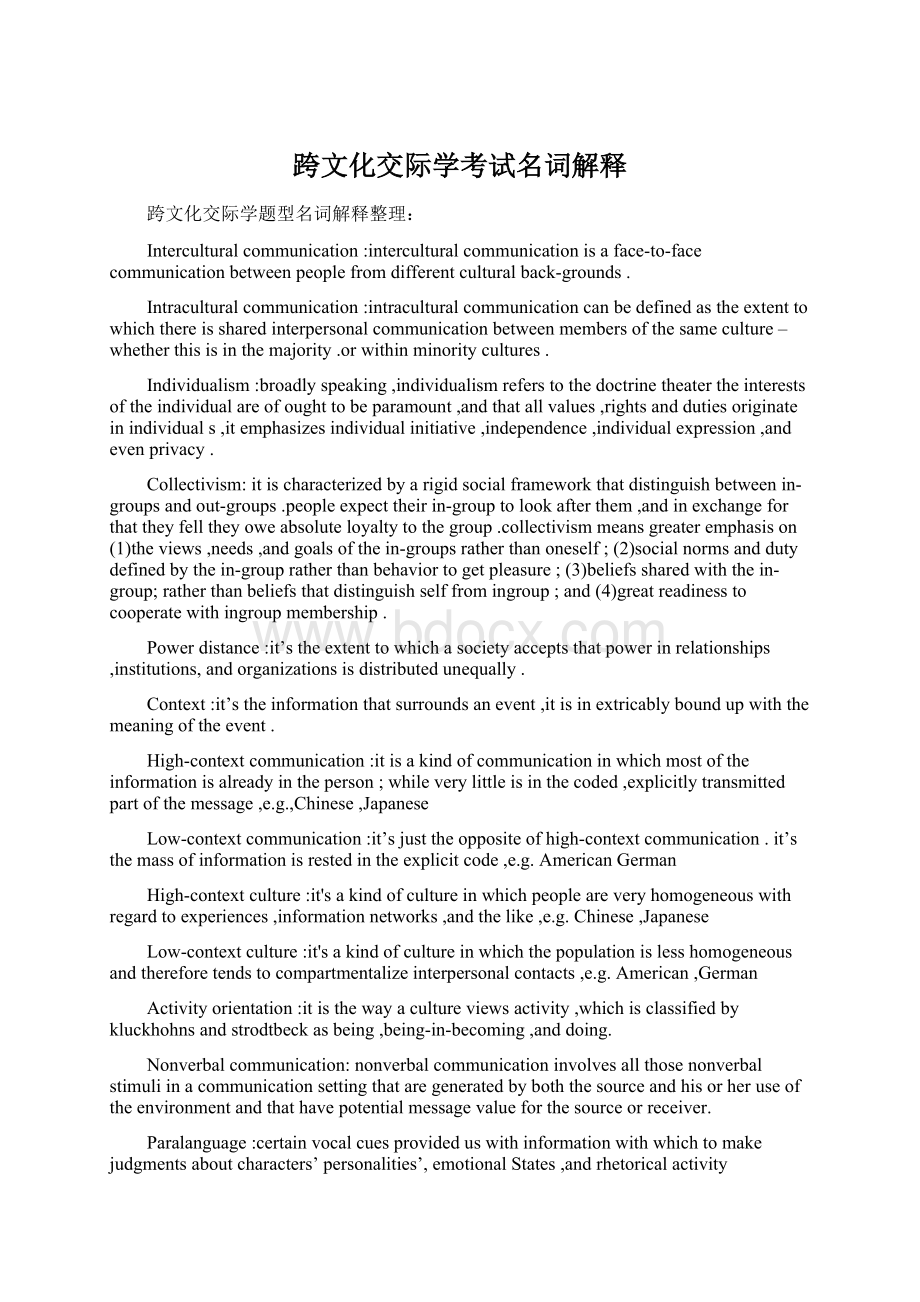跨文化交际学考试名词解释.docx
《跨文化交际学考试名词解释.docx》由会员分享,可在线阅读,更多相关《跨文化交际学考试名词解释.docx(6页珍藏版)》请在冰豆网上搜索。

跨文化交际学考试名词解释
跨文化交际学题型名词解释整理:
Interculturalcommunication:
interculturalcommunicationisaface-to-facecommunicationbetweenpeoplefromdifferentculturalback-grounds.
Intraculturalcommunication:
intraculturalcommunicationcanbedefinedastheextenttowhichthereissharedinterpersonalcommunicationbetweenmembersofthesameculture–whetherthisisinthemajority.orwithinminoritycultures.
Individualism:
broadlyspeaking,individualismreferstothedoctrinetheatertheinterestsoftheindividualareofoughttobeparamount,andthatallvalues,rightsanddutiesoriginateinindividuals,itemphasizesindividualinitiative,independence,individualexpression,andevenprivacy.
Collectivism:
itischaracterizedbyarigidsocialframeworkthatdistinguishbetweenin-groupsandout-groups.peopleexpecttheirin-grouptolookafterthem,andinexchangeforthattheyfelltheyoweabsoluteloyaltytothegroup.collectivismmeansgreateremphasison
(1)theviews,needs,andgoalsofthein-groupsratherthanoneself;
(2)socialnormsanddutydefinedbythein-groupratherthanbehaviortogetpleasure;(3)beliefssharedwiththein-group;ratherthanbeliefsthatdistinguishselffromingroup;and(4)greatreadinesstocooperatewithingroupmembership.
Powerdistance:
it’stheextenttowhichasocietyacceptsthatpowerinrelationships,institutions,andorganizationsisdistributedunequally.
Context:
it’stheinformationthatsurroundsanevent,itisinextricablyboundupwiththemeaningoftheevent.
High-contextcommunication:
itisakindofcommunicationinwhichmostoftheinformationisalreadyintheperson;whileverylittleisinthecoded,explicitlytransmittedpartofthemessage,e.g.,Chinese,Japanese
Low-contextcommunication:
it’sjusttheoppositeofhigh-contextcommunication.it’sthemassofinformationisrestedintheexplicitcode,e.g.AmericanGerman
High-contextculture:
it'sakindofcultureinwhichpeopleareveryhomogeneouswithregardtoexperiences,informationnetworks,andthelike,e.g.Chinese,Japanese
Low-contextculture:
it'sakindofcultureinwhichthepopulationislesshomogeneousandthereforetendstocompartmentalizeinterpersonalcontacts,e.g.American,German
Activityorientation:
itisthewayacultureviewsactivity,whichisclassifiedbykluckhohnsandstrodtbeckasbeing,being-in-becoming,anddoing.
Nonverbalcommunication:
nonverbalcommunicationinvolvesallthosenonverbalstimuliinacommunicationsettingthataregeneratedbyboththesourceandhisorheruseoftheenvironmentandthathavepotentialmessagevalueforthesourceorreceiver.
Paralanguage:
certainvocalcuesprovideduswithinformationwithwhichtomakejudgmentsaboutcharacters’personalities’,emotionalStates,andrhetoricalactivity.Paralanguageinvolvesthelinguisticelementsofspeech,thatis,howsomethingissaidandnottheactualmeaningofthespokenwords.mostclassificationsdivideparalanguageintothreekindsofvocalizations;vocalcharacterizers;vocalqualifiers;andvocalsegregates
M-time(monochromictimeschedule):
M-timeculturestendtothinkoftimeassomethingfixedinnature,somethingaroundusandfromwhichwecannotescape;andever-presentpartoftheenvironment,justliketheairwebreathe
P-time(polychromictimeschedule):
P-timeculturesdealwithtimeholisticallyandplacegreatstockintheactivityoccurringatthemoment.Polychronictimeculturesemphasizepeoplemorethanschedules.ForP-timecultures,timeislesstangibleandhencefeeingofwastedtimearenotasprevalentasM-timecultures.
15.Denotation:
theliteralmeaningordefinitionofaword---theexplicit,particular,definedmeaning.
16.Connotation:
thesuggestivemeaningofaword---allthevalues,judgment,andbeliefsimpliedbyawordthehistoricalandassociativeaccretionoftheunspokensignificancebehindtheliteralmeaning.
19.Chronemics(时间学):
Thestudyofhowpeopleperceiveandusetime.
20.Proxemics(空间学):
referstotheperceptionanduseofspace.
21.kinesics(肢体语言):
Thestudyofbodylanguage.
22.Paralanguage(副语言):
Involvingsoundsbutnotwordandlyingbetweenverbalandnonverbalcommunication.
23.Monochronictime一元时间观念:
meanspayingattentiontoanddoingonlyonethingatatime.
24.Polychronictime多元时间观念:
meansbeinginvolvedwithmanythingsatonce
1.Whatarethefourtrendsthatleadtothedevelopmentoftheglobalvillage?
P8~9
Fourtrendsthatleadtothedevelopmentoftheglobalvillage:
Convenienttransportationsystems/Innovativecommunicationsystems/Economicglobalization/Widespreadmigrations
2.Whatarethethreeaspectswhereculturaldifferencesexist?
Verbaldifference:
language,thoughtpatterns…
Non-verbalcommunication:
body-language,timeconcept,spaciouslanguage,paralanguage,environment…
Perception:
values,worldviews,beliefs,attitudes
3.Whatarethreeingredientsofculture?
文化的三个成分(threeIngredients)P5~6
Ansharedartifact(thematerialandspiritualproductspeopleproduce)
sharedBehavior(whattheydo)
sharedConcepts(beliefs,values,worldviews……whattheythink)
4.HowtounderstandculturalIceberg?
P6~7
Likeanicebergwhatwecanseeaboutcultureisjustthetipoftheiceberg;themajorityofitisintangible,beyondsight.andthepartofculturethatisvisibleisonlyasmallpartofamuchbiggerwhole.Itissaidnine-tenthofcultureisbelowthesurface.
(Justasanicebergwhichhasavisiblesectionabovethewaterlineandalargerinvisiblesectionbelowthewaterline,culturehassomeaspectsthatareobservableandothersthatcanonlybesuspectedandimagined.Alsolikeaniceberg,thepartofculturethatisvisibleisonlyasmallpartofamuchbiggerwhole.Itissaidnine-tenthofcultureisbelowthesurface.(P7))
5.Whatarethetourcharacteristicsofculture?
Dynamic/shared/learned/ethnocentric
Cultureisshared.Allcommunicationstakeplacebymeansofsymbols.
Cultureislearned.Cultureislearned,notinherited.Itderivesfromone’ssocialenvironment,notfromone’sgenes.Enculturation(文化习得):
Alltheactivitiesoflearningone’sculturearecalledenculturation.
Cultureisdynamic.(P6)Cultureissubjecttochange.It’sdynamicratherthanstatic,constantlychangingandevolvingundertheimpactofeventsandthroughcontactwithothercultures.Acculturation(文化适应):
theprocesswhichadoptsthechangesbroughtaboutbyanothercultureanddevelopsanincreasedsimilaritybetweenthetwocultures.
Cultureisethnographic(文化中心主义).Ethnographicisthebeliefthatyourownculturalbackgroundissuperior.Ethnocentrism:
thebeliefthatyourownculturebackgroundissuperior.
6.Whatarethesixcharacteristicsofcommunication?
Dynamic/irreversible/symbolic/systematic/transactional/contextual
Communicationisdynamic.
Communicationisongoing,ever-changingactivity.Awordoractiondoesnotstayfrozenwhenyoucommunicate;itisimmediatelyreplacedwithyetanotherwordoraction.
Communicationisirreversible.
Oncewehavesaidsomethingandsomeoneelsehasreceivedanddecodedthemessage,theoriginalsendercannottakeitback.
Communicationissymbolic.
Symbolsarecentraltothecommunicationprocessbecausetheyrepresentthesharedmeaningsthatarecommunicated.Symbolsarevehiclebywhichthethoughtsandideasofonepersoncanbecommunicatedtoanotherperson.
Communicationissystematic
Communicationdoesnotoccurinisolationorinavacuum,butratherispartofalargesystem.Ittakesplaceinaphysicalandasocialcontext;bothestablishtherulesthatgoverntheinteraction.
Communicationistransactional.(P8)
Atransactionalviewholdsthatcommunicatorsaresimultaneouslysendingandreceivingmessagesateveryinstantthattheyareinvolvedinconversation.
Communicationiscontextual.(P8)
Allcommunicationtakesplacewithinasettingorsituationcalledacontext.Bycontext,wemeantheplacewherepeoplemeet,thesocialpurposeforbeingtogether,andthenatureoftherelationship.Thusthecontextincludesthephysical,social,andinterpersonalsettings.
7.HowisChineseaddressingdifferentfromAmericanaddressing?
(三方面)P22~24
InChinesethesurnamecomesfirstandisfollowedbythegivenname/butinEnglishthisorderisreversed.
Addressingbynames:
InChinaseniorityispaidrespectto.Juniorsaresupposedtoaddressseniorsinaproperway.Theuseofgivennamesislimitedtohusbandandwife,veryclosefriends,juniorsbyeldersorsuperiors/Nowadays,moreandmoreEnglish-speakingpeopleaddressothersbyusingthefirstname,evenwhenpeoplemeetforthefirsttime.(intimacyandequality)
Addressingbyrelationship:
Chineseoftenextendkinshiptermstopeoplenotrelatedbybloodormarriage.Thesetermsareusedafterthesurnametoshowpolitenessandrespect/TheEnglishequivalentsoftheabovekinshiptermsarenotsoused.Evenwithrelatives,Americanstendtousejustthefirstnameandleaveoutthetermofrelationship.
Addressingbytitle,office,profession:
AnothercommonChineseformofaddressistheuseofaperson’stitle,office,professiontoindicatetheperson’sinfluentialstatus.InEnglish,onlyafewoccupationsortitlescouldbeused.(P24)Americanstendtoregardtitlesastrivialunlesstheyhaveaclearideaofwhatkindofworkapersondoesandwhathisresponsibilitiesare.
8.HowistheChinesewritingstyledifferenttheAmericanwritingstyle?
TheChineseemployacircularapproachinwriting.Inthiskindofindirectwriting,thedevelopmentoftheparagraphmaybesaidtobe‘turningandturninginawideninggyre’.Thecirclesorgyresturnaroundthesubjectandshowitfromavarietyoftangentialviews,butthesubjecti